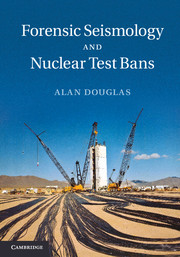Book contents
- Frontmatter
- Contents
- Preface
- Abbreviations and mathematical symbols
- Prologue
- 1 Seismology: ancient and modern
- 2 Statistical solutions to seismological problems
- 3 Seismograms as time series
- 4 Seismographs and seismograms
- 5 Seismometer arrays and processing methods
- 6 Seismogram interpretation and synthesis
- 7 Hypocentres and P travel times
- 8 Seismic magnitudes
- 9 Seismic source identification
- 10 Epilogue
- Appendix A P and S radiation from a double-couple source
- Appendix B Normal equations for analysis of variance
- Appendix C Some uses of the FFT
- Appendix D Anelastic attenuation
- Appendix E The relation of the transient and steady-state responses
- Appendix F Seismometer–galvanometer systems
- Appendix G SNI from summing array recordings
- Appendix H The equations for computing MP filters
- Appendix I Circular arrays
- Appendix J Geometrical spreading when S reflects as sP
- Appendix K The Fourier integral for a dispersed wave train
- Appendix L Tables of explosions and earthquakes
- Appendix M Album of body-wave seismograms
- Appendix N Exercises
- References
- Further reading
- Author index
- Index
Appendix L - Tables of explosions and earthquakes
Published online by Cambridge University Press: 05 March 2013
- Frontmatter
- Contents
- Preface
- Abbreviations and mathematical symbols
- Prologue
- 1 Seismology: ancient and modern
- 2 Statistical solutions to seismological problems
- 3 Seismograms as time series
- 4 Seismographs and seismograms
- 5 Seismometer arrays and processing methods
- 6 Seismogram interpretation and synthesis
- 7 Hypocentres and P travel times
- 8 Seismic magnitudes
- 9 Seismic source identification
- 10 Epilogue
- Appendix A P and S radiation from a double-couple source
- Appendix B Normal equations for analysis of variance
- Appendix C Some uses of the FFT
- Appendix D Anelastic attenuation
- Appendix E The relation of the transient and steady-state responses
- Appendix F Seismometer–galvanometer systems
- Appendix G SNI from summing array recordings
- Appendix H The equations for computing MP filters
- Appendix I Circular arrays
- Appendix J Geometrical spreading when S reflects as sP
- Appendix K The Fourier integral for a dispersed wave train
- Appendix L Tables of explosions and earthquakes
- Appendix M Album of body-wave seismograms
- Appendix N Exercises
- References
- Further reading
- Author index
- Index
Summary
Table L.1 lists seismic source details of the nuclear explosions referred to in the main body of the book or in Appendix M. For many of the explosions, seismograms are shown. Table L.2 lists the details of some conventional explosions, most of which have been used for travel time calibration and some for magnitude–yield and source identification studies. For the CHASE series old military explosives were packed into obsolete cargo ships, towed to deep water sites and scuttled (Kibblewhite and Denham, 1969). It was not originally intended that the explosives would be detonated and the first ship, CHASE I, sank without incident. CHASE II, however, exploded spontaneously on sinking. Several groups including the US Office of Naval Research and the Advanced Research Projects Agency realized that such explosions with known epicentre and origin time could be valuable for seismic and acoustic travel-time studies. Several of the later ships were instrumented to detonate at prescribed depth and location. AWE Blacknest used the P times from several of the CHASE explosions in their studies for the estimation of travel-time tables.
The accidental explosion that sank the Russian nuclear submarine, the Kursk, was the subject of detailed study by AWE Blacknest to try to unravel the sequence of events that led to the destruction of the vessel (see Bowers and Selby (2009), Truscott (2002)).
Table L.3 lists hypocentres, origin times and magnitudes for earthquakes referred to in the book. Seismograms from some of the earthquakes are shown in the main body of the book or in Appendix M.
- Type
- Chapter
- Information
- Forensic Seismology and Nuclear Test Bans , pp. 413 - 418Publisher: Cambridge University PressPrint publication year: 2013



